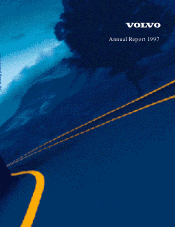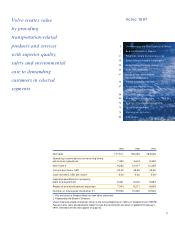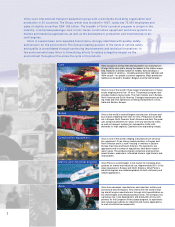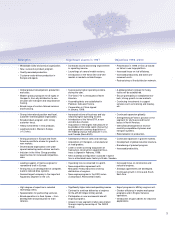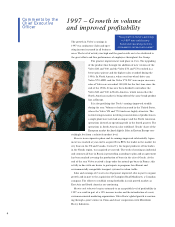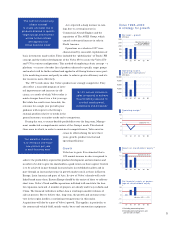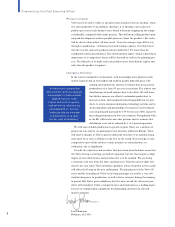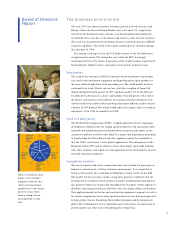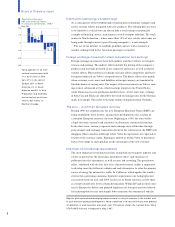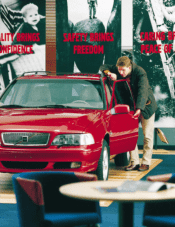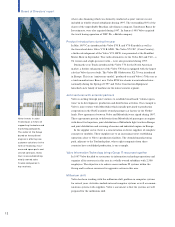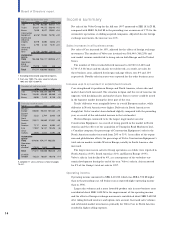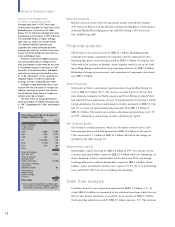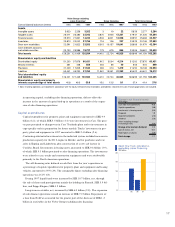Volvo 1997 Annual Report Download - page 9
Download and view the complete annual report
Please find page 9 of the 1997 Volvo annual report below. You can navigate through the pages in the report by either clicking on the pages listed below, or by using the keyword search tool below to find specific information within the annual report.
7
The business environment
The year 1997 was characterized by economic growth in North America and
Europe, where the Gross National Product rose 3.6% and 2.4%, respectively.
Growth in the Southeast Asian countries was slowed significantly during the
second half of the year due to the finance and currency crisis in many countries.
The crisis was characterized by declining currencies and share prices in ASEAN
countries and Korea. The trend in the region continued to be turbulent during
the early part of 1998.
The average exchange rate for the U.S. dollar relative to the Swedish krona
strengthened by nearly 15% during the year, while the ECU was largely
unchanged relative to the krona. Large parts of the world economy experienced
historically low inflation with a consequent weak growth in interest rates.
Total market
The trend of the economy in OECD countries favored investments in passenger
cars, trucks and construction equipment and kept demand for these products at
the same relatively high level of the preceding year. The world market for buses
continued to be weak. Vehicle sales in Asia (with the exception of Japan) fell
sharply during the fourth quarter of 1997 and decreased by 7% for the full year.
It is difficult to determine in a short- and medium-term perspective what effects
the finance and currency crisis will have on economic growth in Southeast Asia
and the trend of the market reflects growing uncertainty. Industry analysts foresee
a decline of 30% during 1998, which would reduce the region’s share of world car
sales from 11% in 1996 to around 8% in 1998.
Trend of trading policy
The World Trade Organization (WTO) is highly important for the continuing
development of global rules for trading and investing that will also permit open,
equitable and nondiscriminatory trading between countries and regions, in the
automotive industry as well as other fields. It is urgent that negotiations pertaining
to membership for China, Russia and other applicant nations be concluded so
that the WTO can become a truly global organization. The enlargement of the
European Union (EU) and its efforts to create increasingly open trade relations
with other countries and regions are also important for the development of more
favorable operating conditions.
Com petitive situation
The excess capacity and severe competition that exists within the passenger car
industry is characteristic of Volvo’s business environment. It is a trend that is
being accentuated by the continuing establishment of new entries in the field.
The market for heavy trucks is under strong price pressure combined with the
introduction of a number of new product concepts, including financing and leas-
ing. Intensive efforts are being made throughout the transport vehicle industry to
distribute increasing investments and other costs over larger volumes of business.
This applies primarily in the bus and construction equipment segments as well as
for vehicle components where many small manufacturers are being incorporated
in large groups that are broadening their product programs and becoming more
global. The establishment of new operations and various forms of cooperation in
growth markets are other ways of broadening the volume base.
Brunswick
Cummins
Caterpillar
Volvo
Yanmar
Caterpillar
Komatsu
Hitachi
Volvo
JI Case
Evo Bus
(Setra Mercedes)
Volvo
Hino
Scania
MAN
Mercedes
Paccar
Volvo
Renault
Scania
Marine
and in-
dustrial
engines
Cars
Trucks
Buses
Con-
struction
Equip-
ment
BMW
Mercedes Benz
Audi
Volvo
Lexus
Volvo is a relatively sm all
player in the transport
equipm ent industry. But,
relative to the principal
com petitors in the various
business areas, Volvo
holds a strong interna-
tional position in each
area.
Board of Directors’
Report

